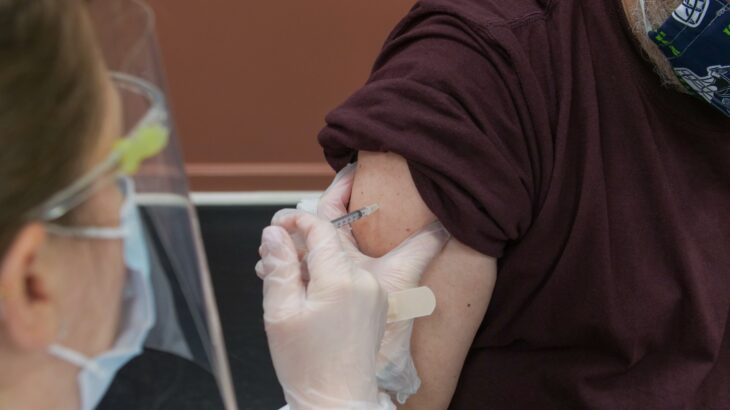By Dorottya Harangi, Health, Medicine & Veterinary Sciences co-editor

Influenza A, one of the most common types of influenza in humans and one of the strains included in the yearly flu vaccine. Image: Centers for Disease Control and Prevention Public Health Library/ Dr. Erskine Palmer.
If you live in Canada, you know that every flu season you are bombarded with messages about getting your flu shot. Experts advise people to get their flu shot as soon as it becomes available, as it takes 2 weeks for the vaccine to take effect. However, despite widespread advertising, flu shot uptake hovers around 48% in the general Canadian population. This is much lower than the 93% who reportedly received 2 shots of the COVID vaccine. In the 65+ population, the uptake rate of the flu shot is 70%; however this is still significantly below the 80% mark that experts would like to see.
Although some people think of it as “just the flu,” every year the flu hospitalizes approximately 12,000 Canadians and leads to 3,500 deaths. The flu is especially dangerous for the elderly and people with comorbidities such as diabetes or heart disease. Increasing flu shot uptake will require education to help people understand why they need to get their flu shot, and reduced barriers to improve ease of access to the vaccine. Otherwise, Canada will continue to face an uphill battle with flu epidemics and an overburdened hospital system.
How the flu shot is made each year
The flu shot varies slightly every year, but all formulations have some strains of influenza A and B, as these are the most common types of viruses affecting humans. The strains of influenza A and B selected each year for the vaccine depend on a few factors. Every year, there are influenza centers all over the world monitoring flu patterns. This includes which strains are in circulation, which are making people sick, if the strain has previously been targeted by a vaccine, and how effective that vaccine was. All these influenza centers send their data to five World Health Organization (WHO) Collaborating Centers for Influenza. Based on this data, scientists at these centers determine the most virulent strains for the upcoming year. In February each year, a group of consultants meet to decide the makeup of the vaccine for that year. This group consists of the directors of the WHO Collaborating Centers for Influenza, members of Essential Regulatory Laboratories from 4 different countries, as well as other subject matter experts.
How to increase flu shot uptake
For many people, there is no reason behind not getting the flu shot. In a survey conducted by the National Institute on Aging, the most popular response, at 30%, was “No specific reason, I just didn’t get it”, followed by “I did not get around to it” at 14%. The results of this survey show that ease of access is key to getting more Canadians to take their flu shot. One way this “convenience” factor is being addressed is by pharmacies offering flu shots, allowing people to stop in on their way to the grocery store or work to quickly get the shot. For those who are unable to make it to a local pharmacy due to physical restrictions or lack of transportation, mobile flu clinics can be a great option. For example, in 2021, there was a mobile flu shot clinic in East Toronto , where nurses went door-to-door at community housing units to administer flu shots to some of Toronto’s most vulnerable residents. The initiative was a great success, both in terms of the number of people vaccinated, and getting the shots to people who wanted them but wouldn’t have had access otherwise. Canada could benefit from more mobile flu clinics to help vaccinate those who are homebound or have trouble getting to a pharmacy or community pop-up.

Education by healthcare providers is important, with multiple surveys reporting people place significant emphasis on advice from their healthcare providers. Image: Max on Pixabay.
Education by healthcare providers is important, with multiple surveys reporting people place significant emphasis on advice from their healthcare providers. Image: Max on Pixabay.Some pharmacies are also making getting your flu shot easier by offering it at the same time as the COVID shot. When I booked my flu shot at Shoppers Drug Mart, I was asked if I wanted to get my COVID booster at the same time. The booking website also offers the option to add on a flu shot when you book your COVID booster vaccine. For anyone above the age of 5, it is safe to get both shots at the same time, as long as they are at different injection sites. By letting you add on the other shot, as well as offering walk-in appointments, pharmacies are increasing the ease of access for people who are busy or can’t get out of the house as often.
Another factor that affects flu vaccine uptake is proper education and awareness. Family doctors, pharmacists, and other frontline healthcare workers are key to getting the proper message out. A survey done by CSL Seqirus, a major influenza vaccine company, found that parents who talked to their healthcare provider about the flu vaccine reported that they would be more likely to take their child to get the shot. Amongst the adult population, multiple studies have shown that advice and recommendations given by their healthcare providers has an impact on their likelihood of receiving their flu shot. In one of the surveys, 71% of those surveyed said their healthcare providers advice played a vital role.
mRNA flu vaccines
Building on the success of mRNA COVID vaccines, pharmaceutical companies are leveraging the technology to improve upon flu vaccines. Using mRNA vaccine technology, some research institutions and companies are looking into creating an mRNA flu vaccine that would target all strains in one shot—this would avoid the need to decide which flu strains to incorporate and instead target them all. A study done at the University of Pennsylvania has had preliminary success in the preclinical phase with animals. There are various pharmaceutical companies in the process of conducting clinical trials with an mRNA flu vaccine. Moderna started administering vaccine doses in a clinical trial they are running in the Southern Hemisphere back in June, as flu season in the Southern Hemisphere starts a few months earlier than in the USA. Pfizer is starting off in the Northern Hemisphere, having administered its first doses in September, in a larger USA-based clinical trial of 25,000 participants. However, even if an mRNA flu shot is successfully created and passes regulatory approval, it won’t have much impact if there isn’t a strong uptake by the population.
Currently, there doesn’t seem to be a strong reason for the low uptake of the flu shot, as many people report that they just “didn’t get around to it”. It is important to bring up flu shot uptake as it can be a severe illness, especially in the elderly population, and puts lots of pressure on the healthcare system. In addition to research and development, accessibility and awareness are crucial for the success of the flu vaccine. It will take a combined education effort by provincial and federal governments as well as healthcare providers to tackle these issues.
Feature image: Getting the flu shot every year is important to protect yourself and others. Photo: Steven Cornfield on Unsplash.




